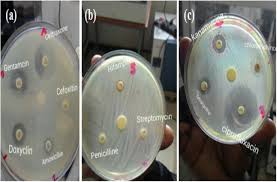Bacterial Profile and Their Antimicrobial Susceptibility Pattern of Isolates Recovered from Intensive Care Units of Libyan Hospitals.
DOI:
https://doi.org/10.69667/rmj.25311Keywords:
Hospital-Associated Infection, Antibiotic Resistance, ICU, Public Health, Misurata, Libya.Abstract
Presence of Bacterial contamination in hospital environments, particularly intensive care units, poses a serious threat to global public health in the world with high morbidity and mortality rates. Of more concern is the emergence of multidrug-resistant bacteria on medical devices, inanimate surfaces, health care providers, and patients in the intensive care unit, which could lead to further cross-contamination and infection. This study aimed to assess the bacterial profile and their antimicrobial susceptibility patterns of bacterial isolates from the intensive care unit of the Emergency unit, internal medicine, and coronary unit of Misurata Central Unit of Misurata, Libya. A unit-based cross-sectional study was conducted on three Intensive Care units from 1st December 2024 to 27th December 2024. In this project, a total of 102 swab samples from the intensive care unit environment were collected using cotton swabs. Standard Microbiological techniques to include culture method and Gram stain, were employed for the identification of the isolates. Antimicrobial susceptibility tests for bacterial isolates were performed by using the Kirby-Bauer disk diffusion method. In the total of 102 swab samples, bacterial growth was observed in 19.6% (20/102) of the total samples. Out of the total bacterial growth recovered, the Coronary care unit had the highest, 50% (10/20), followed by the Emergency unit 35% (7/20), and the Internal medicine unit had 15% (3/20). The most frequently found isolate was Staphylococcus aureus 75% (15/20), followed by Streptococcus pyogenes 15% (3/20), Pseudomonas aeruginosa 5% (1/20), and E coli 5% (1/20). Results of the antibiotic susceptibility pattern revealed that most of the isolates are multidrug-resistant. Results from this study showed bacterial contamination of the ICU environments and their resistance patterns, which suggest that patients are prone to hospital-associated infection. It is recommended that strict sterilization of intensive care units be standardized and the hygiene of hospital workers be enforced to prevent transmission of infection in hospital environments.

Downloads
Published
Issue
Section
How to Cite
Most read articles by the same author(s)
- Ahmed Alsharksi, Abdalla Ali, Adam Mustapha, Clostridium difficile A-B Toxins as a Cause of Diarrheal Disease: Data from a University Hospital in Northern Cyprus , Razi Medical Journal: Volume 1, Issue 4, 2025 (October to December)
Similar Articles
- Tarik Enaairi, Sundus Aldeebani, Hawa Abduljalil, Buschke-Fischer-Brauer Keratosis Punctata of the Palmar Creases in A 45-Year-Old Libyan Female: A Case Report , Razi Medical Journal: Volume 1, Issue 3, 2025
- Nadia Alrawaiq, Fatima Younis, Mabrouka Ismail, Identification and Evaluation of Drug-Related Problems in Patients with Reduced Kidney Function: A Retrospective Study , Razi Medical Journal: Volume 1, Issue 3, 2025
- Hossam Elkaib, Abu Baker Abdulrhman, Ali Elrahal, Parathyroid Hormone, Calcium, and Phosphorus Levels in Chronic Kidney Disease Patients: A Comprehensive Analysis , Razi Medical Journal: Volume 1, Issue 3, 2025
- Md Sayed Ali Sheikh, Umme Salma, Maternal Plasma Lipid Profile as a Potential Risk Factor for Spontaneous Preterm Labor , Razi Medical Journal: Volume 1, Issue 2, 2025
- Khaled Smeo, Evaluation of Wound Healing and Pain Perception After Frenectomy Using 810 Nm Diode Laser in A Young Patient: A Case Report , Razi Medical Journal: Volume 1, Issue 4, 2025 (October to December)
You may also start an advanced similarity search for this article.








